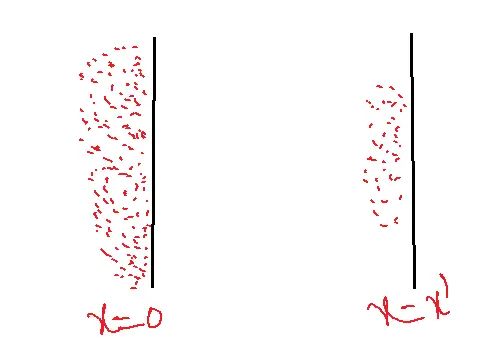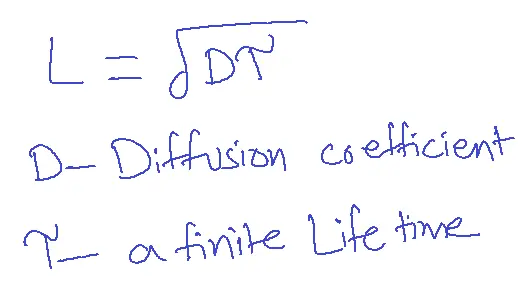Drift Current and Diffusion current play key roles in semiconductor devices. In semiconductors, both drift current and diffusion current co-occur, and their combination of drift current and diffusion current determines the overall current flow. Understanding Drift Current and Diffusion Current currents is crucial for designing and analyzing electronic devices.
Table of Contents
Drift Current
Drift current is the movement of charged particles, such as electrons or holes, in a conductor or semiconductor due to an external electric field. It results from the electric field applying a force on the charged particles, causing them to move in a specific direction.
When an electric field is applied across semi-conductor material, the charge carriers attain a certain drift velocity equal to the product of µ and E, and the applied electric field.
Holes move towards the negative terminal of the battery.
Electrons move towards the positive terminal of the battery.
The combined effect of the movement of charge carriers constitutes a drift current. This Drift current is defined as the flow of electric current due to the motion of charge carriers under the influence of an external electric field.
Jn=n µneE
Jp=p µpeE
Jn=n µneE→current density due to electrons
Jp=p µpeE→current density due to holes
J= Jn+ Jp
J= n µneE+ p µpeE
Key Points
1. Electric Field: An external electric field is applied to the conductor or semiconductor.
2. Force on Charged Particles: The electric field exerts a force on the charged particles, causing them to move.
3. Direction of Movement: The charged particles move toward the electric field.
4. Velocity: The velocity of the charged particles is proportional to the strength of the electric field.
5. Conductor or Semiconductor: Drift current occurs in conductors or semiconductors, where charged particles can move freely.
Types of Drift Current
1. Electron Drift Current: The movement of electrons in a conductor or semiconductor.
2. Hole Drift Current: The movement of holes (positive charge carriers) in a semiconductor.
Advantages of Drift Current
1. Fast Response Time: Drift current responds quickly to changes in the electric field.
2. High Sensitivity: Drift current is sensitive to small changes in the electric field.
3. Low Noise: Drift current is less susceptible to noise and interference.
4. Easy to Control: Drift current can be easily controlled by adjusting the electric field.
5. High Speed: Drift current allows for high-speed operation in electronic devices.
Disadvantages of Drift Current
1. Dependence on Electric Field: Drift current requires a strong electric field to operate.
2. Limited Dynamic Range: Drift current has a limited dynamic range, making it less suitable for applications with large signal variations.
3. Temperature Dependence: Drift current is affected by temperature changes, which can impact device performance.
4. Material Dependence: Because drift current depends on material characteristics, device design freedom may be restricted.
5. Difficult to Measure: Drift current can be challenging to measure directly, requiring indirect measurement techniques.
Applications of Drift Current
1. Electronic Devices: Drift current is used in electronic devices like diodes, transistors, and thyristors.
2. Solar Cells: Drift current helps collect charge carriers in solar cells.
3. Particle Detectors: Drift current is used in particle detectors to measure the movement of charged particles.
4. Magnetic Field Sensors: Drift current is used in magnetic field sensors to detect changes in magnetic fields.
5. Hall Effect Sensors: Drift current is used in Hall effect sensors to measure magnetic fields.
6. Electronic Switches: Drift current is used in electronic switches like thyristors and triacs.
7. Rectifiers: Drift current is used in rectifiers to convert AC to DC.
8. Power Supplies: Drift current is used in power supplies to regulate output voltage.
9. Aerospace Applications: Drift current is used in aerospace applications like radiation detection and particle measurement.
10. Medical Devices: Drift current is used in medical devices like radiation therapy equipment and medical imaging devices.
Diffusion Current
Diffusion current is the movement of charged particles (electrons or holes) in a semiconductor material due to a concentration gradient (difference in particle density). It is a result of the random thermal motion of particles, causing them to diffuse from high-concentration areas to low-concentration areas.
A concentration gradient inside a semiconductor material allows for the flow of electric current even in the absence of an applied electric field. A concentration gradient exists when the number of electrons or holes is greater in one region of a semiconductor compared to the rest of the region. In semi-conductor material, the charge carriers tend to move from higher to lower concentrations of the same charge carriers.
This movement of charge carriers results in a current called diffusion current.

A non-uniform concentration of charge carriers
There is a gradient in concentration because, as the image illustrates, the concentration of holes changes non-uniformly with distance x.
Therefore, current due to diffusion of holes
Jp= -qDp A/m2
Dp– Diffusion coefficient
dp/dx- the rate of change of hole concentration with distance x
Jp= Diffusion current density due to holes
Jn= q Dn A/m2
Jn= Diffusion current density due to electrons
dn/dx- concentration gradient for electrons
The total current in the semi-conductor material is the sum of the Drift current and Diffusion current.
Jp= pµpeE-eDp
Jn= nµneE+eDn
Key Points
1. Concentration Gradient: Diffusion current occurs due to a concentration gradient in the semiconductor material.
2. Random Thermal Motion: Particles move randomly due to thermal energy, causing diffusion.
3. No Electric Field: Diffusion current occurs without an external electric field.
4. Particle Movement: Particles move from high-concentration areas to low-concentration areas.
5. Semiconductor Material: Materials used in semiconductors, such as silicon, experience diffusion current.
Types of Diffusion Current
1. Electron Diffusion Current: Movement of electrons in a semiconductor.
2. Hole Diffusion Current: Movement of holes (positive charge carriers) in a semiconductor.
Advantages of Diffusion Current
1. No External Electric Field Required: Diffusion current occurs without an external electric field.
2. High Sensitivity: Diffusion current is sensitive to small changes in concentration gradients.
3. Low Noise: Diffusion current is less susceptible to noise and interference.
4. Easy to Implement: Diffusion current is easy to implement in semiconductor devices.
5. High Efficiency: Diffusion current can lead to high efficiency in solar cells and semiconductor devices.
Disadvantages of Diffusion Current
1. Slow Response Time: Diffusion current responds slowly to changes in concentration gradients.
2. Limited Dynamic Range: Diffusion current has a limited dynamic range, making it less suitable for applications with large signal variations.
3. Temperature Dependence: Diffusion current is affected by temperature changes, which can impact device performance.
4. Material Dependence: Because diffusion current depends on material characteristics, device design flexibility may be limited.
5. Difficult to Control: Diffusion current can be challenging to control, as it relies on random thermal motion.
Applications of Diffusion Current
1. Solar Cells: Diffusion current helps within the assortment of charge carriers in solar cells, increasing efficiency.
2. Semiconductor Devices: Diffusion current is crucial in semiconductors like diodes, transistors, and integrated circuits.
3. Bipolar Junction Transistors: Diffusion current plays a key role in the bipolar junction transistors.
4. Thyristors: Thyristors, such as silicon-controlled rectifiers (SCRs), employ diffusion current.
5. Power Supplies: Diffusion current is used in power supplies to regulate output voltage.
6. Aerospace Applications: Diffusion current is used in aerospace applications like radiation detection and particle measurement.
7. Medical Devices: Diffusion current is used in medical devices like radiation therapy equipment and medical imaging devices.
8. Optoelectronic Devices: Diffusion current is used in optoelectronic devices like photodiodes and phototransistors.
9. Sensors: Sensors for pressure and temperature employ diffusion current.
10. Memory Devices: Diffusion current is used in devices like DRAM and flash memory.
Comparisons between Drift Current and Diffusion Current
Similarities between Drift Current and Diffusion Current
1. Drift Current and Diffusion Current are types of electric current.
2. Drift Current and Diffusion Current occur in semiconductors.
3. Drift Current and Diffusion Current involve the movement of charge carriers (electrons or holes).
Differences of Drift Current and Diffusion Current
1. Cause: Concentration gradients and external electric fields create differential currents in Drift Currents and Diffusion Currents.
2. Direction of Drift Current and Diffusion Current: Drift current moves particles in the direction of the electric field, while diffusion current moves particles from high-concentration areas to low-concentration areas.
3. Velocity: Drift current velocity is proportional to the electric field strength, while diffusion current velocity is proportional to the concentration gradient.
4. Electric Field: Drift current requires an external electric field, while diffusion current does not.
5. Response Time: Drift current responds quickly to changes in the electric field, while diffusion current responds slowly to changes in concentration gradients.
6. Material: Drift current occurs in conductors or semiconductors, while diffusion current occurs specifically in semiconductors.
7. Control: Drift current is easy to control by adjusting the electric field, while diffusion current is challenging to command.
Einstein Relationship
The mobility and diffusion coefficient of a certain kind of charge carrier inside the same semiconductor have a clear correlation.
The tendency to disseminate will increase with increasing mobility values.
The equation which relates mobility(µ) and differential coefficient(D) is the Einstien relationship.
Dp/µp=Dn/µn=kT/q=VT
| Dp | Dn | |
| Silicon(Si) | 13 cm2/sec | 34 cm2/sec |
| Germanium(Ge) | 47 cm2/sec | 99 cm2/sec |
Diffusion Length
Diffusion Length is the average distance a charge carrier may diffuse throughout its lifespan.

FAQs
1. What is drift current?
- Drift current is the flow of electric charge carriers (electrons or holes) caused by an applied electric field.
- It’s similar to how water flows downhill in a river.
- The stronger the electric field, the faster the carriers drift and the higher the drift current.
2. What is diffusion current?
- Diffusion current is the flow of charge carriers due to a concentration gradient.
- It’s similar to the spread of ink in water, moving from regions of high concentration to low concentration.
- Diffusion current occurs even in the absence of an electric field.
3. What’s the difference between drift current and diffusion current?
- Driving force: An electric field drives drift current, while a concentration gradient drives diffusion current.
- Direction: Drift current flows in the same direction as the electric field for holes and opposite for electrons. Diffusion current flows from high to low carrier concentration.
- Dependence: Drift current depends on carrier mobility and electric field strength. Diffusion current depends on the diffusion coefficient and concentration gradient.
4. Where are drift current and diffusion current important in electronic devices?
- Semiconductor devices: Drift Current and Diffusion Current play crucial roles in diodes, transistors, and other semiconductor devices.
- Drift current is dominant in the depletion region of a PN junction under forward bias, while diffusion current is responsible for carrier movement across the junction under reverse bias.
5. How are drift current and diffusion current related to the total current in a semiconductor?
- The total current in a semiconductor is the sum of the drift current and diffusion current. The relative contributions of each depend on the device structure, biasing conditions, and carrier concentration gradients.
